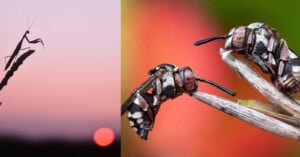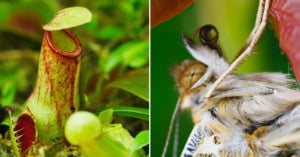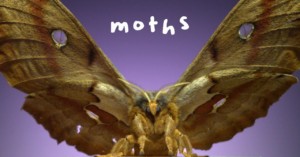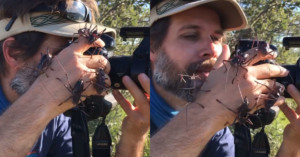
Pair of Sleeping Bees Wins Insect Photography Contest
The Royal Entomological Society has announced the winners of its 2023 insect photography competition.

The Royal Entomological Society has announced the winners of its 2023 insect photography competition.

As part of its Earth Day celebrations, the Mall of America in Bloomington, Minnesota, released 144,000 ladybugs into the mall to help keep its 30,000 live plants and trees healthy and happy. Conservation photographer and friend of PetaPixel Devon Matthews was on hand to document the event.

Scientists have shared the first-ever photographs of a newly discovered species of beetle that was almost mistaken for bird poo.

French photographer Emilie Talpin did not pick up her first camera until 2018 but within just a few years, she became both an OM SYSTEM Ambassador and a highly respected photo educator best known for her favorite photography genres: macro and nature.

Scientists took over 11,000 photos of ants to reveal how the different patterns and textures on their faces could be the secret behind their survival as a species.

Jens Braun of the YouTube channel Another Perspective offers a disturbing close-up look at mosquito larvae in his latest video.

A video artist spent six months photographing flowers blooming and filming insects for an experimental timelapse video on life and war.

Eugenijus Kavaliauskas took this incredible, yet terrifying macro photo of an ant that looks like it's straight out of a horror film.

Joshua Coogler uses a Laowa 25mm Ultra Macro lens to capture sinister close-up pictures of ants.

Growing up in a communist country, we had no access to or real knowledge of the outside world. With the information that we now take for granted tightly controlled, we were living in a bubble. When communism ended, my entire concept of what the planet and all living things were all about changed quickly and dramatically.

Macro insect photographers are up in arms this week after the title of "Bug Photographer of the Year" was awarded to a photographer who drugs his subjects for his ultra-close-up photos.

I've shot thousands of pics of insects without flash and tens of thousands with flash. When the lighting is bright and sunny, the results can be good without flash. But when I venture out in pursuit of photo ops, I often encounter poorly lighted situations which are better with flash. If you study the work of experienced insect photographers, you'll find that most of them use flash.

Dr. Adrian Smith publishes incredibly detailed examinations of insects in motion through his YouTube Channel Ant Lab. While he generally picks backdrops to complement the colors of his subjects, this time he chose to mimic a more classic look.

French artist Thomas Blanchard has produced a creative macro film that features the natural world of both the lifecycle of delicate butterflies and gorgeous detail of carnivorous plants in action.

Macro photography in the field is not always easy or comfortable, often requiring long hours outdoors in the heat. So now more than ever, I’m seeing the benefits of lightweight lenses and bodies.

Photographing insects in the field demands higher shutter speeds, a steady hand, and a smaller aperture to ensure sharpness.

Dr. Adrian Smith regularly publishes unique looks at insects using high-speed cameras. In his latest video, Dr. Smith focuses his lens on seven stunningly beautiful species of moths and captures their movements at a blistering 6,000 frames per second.

Photographer Jens Heidler has recorded a fascinating macro timelapse story of ladybugs hatching that gives viewers a rarely-seen glimpse into the lives of insects.

As you all know, bees help us put food on the table. Their pollination of California almonds alone has been valued at a billion dollars. They have also become my favorite photographic subject. I wrote about this last September.

A group of international robotics researchers has developed an urban search and rescue solution that skirts past the current limitations of miniature robotics through what they are calling an insect computer hybrid system, which fuses a living insect platform with a microcontroller.

Dr. Adrian Smith is well-known for this slow-motion study of insect species and that skill set was perfect for a detailed study of insects known as "springtails." They normally move so fast that normal cameras, as well as the human eye, cannot perceive their motion.

National Geographic photographers can find themselves in all kinds of strange and uncomfortable situations while on assignment and hunting for the perfect shots. Just check out what Nat Geo photographer Thomas Peschak is up to in Africa's Kalahari Desert.

When insects fly by, they do so usually too fast to really notice how they are doing it. They either zip by our periphery or jump into the air so quickly it's hard to tell how they do it. In this 6-minute video, you can truly appreciate the funny ways different species take flight.

Photographer João Burini has published a review of the Laowa Venus 50mm f/2.8 2x Ultra Macro APO for micro four thirds after a long time shooting with the lens. He has captured a large number of beautiful images of insects, and calls the lens "the best macro option in micro four thirds."

Over the weekend, Luminar (yes, that Luminar) unveiled the winners of the first annual Bug Photography Awards: a contest that the photo sharing software came up with in association with Buglife, Europe's leading invertebrate charity.

When filming the award-winning documentary Awavena in the Amazon rainforest, Director of Photography Greg Downing needed a way to capture the extremely dim light given off by various fluorescent plants and insects. So he turned to Canon's specialized ME20F-SH, which can shoot at up to ISO 4,500,000.

Dr. Adrian Smith—a scientist who is perhaps best known for his educational videos on YouTube—has released another fascinating super slow motion video highlighting a tiny little insect you've probably never heard of. They're commonly called jumping plant lice, and they're "the fastest front-flipping insect" on the planet.

NC State Assistant Professor Dr. Adrian Smith recently set out to capture some never-before-seen super slow motion footage for his YouTube channel Ant Lab. The results sit right at the border between "genuinely educational" and "downright stunning."

Belle Ame is an ongoing series by award-winning macro photographer Matt Doogue featuring macro double exposure photos of insects created in-camera.

I’m not your typical conservation photographer. Many conservation photographers and filmmakers spend their careers traveling to infrequently traversed crevices of our earth in pursuit of untold stories of nature and wildlife. I am not so lucky to have traveled the globe, but I have experienced worlds unknown to most. I photograph bugs and share their stories in hopes of changing public perception of insects and spiders.